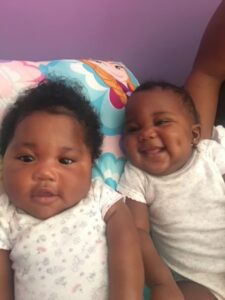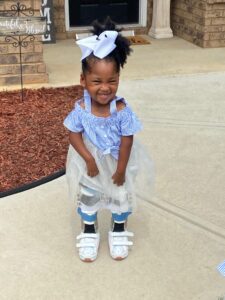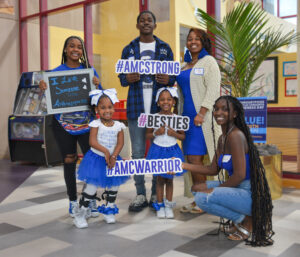Rare Community Profiles

Rare Community Profiles is a new Patient Worthy article series of long-form interviews featuring various stakeholders in the rare disease community, such as patients, their families, advocates, scientists, and more.
Shantel S. and Shriners Children’s are Transforming the Way We Understand Arthrogryposis Multiplex Congenita (AMC)
For the second day in a row, Shantel Smith asked to see her children. Both of them, she requested. At the same time. Please.
When she had finally given birth to her twins MiKenli and MiKenzi, just 45 seconds apart, doctors slid MiKenzi into her arms. Shantel was awash with love and thankful to bring the twins into a loving home, complete with a college-bound eldest sister, an athletic older brother and a dance-obsessed (and competition ready!) older sister.
For the next few days, doctors would pass through the room with MiKenzi; sometimes, they would present Shantel with her daughter, saying that it was MiKenli. But Shantel felt like something was wrong. She begged to see both her children, asking why they were only bringing one. The doctors rolled their eyes; she shares:
“They kept telling me that I just couldn’t tell the twins apart. That they were identical and that’s why something felt off. It wasn’t until later that I learned that they had taken MiKenli and sent her to another hospital over 1.5 hours away. They sent her without informing me and without my consent.”
At birth, MiKenli had looked “different” to hospital staff. She had limb contractures and wasn’t moving as much as they expected. So they sent her to the NICU in another county. It wasn’t until Shantel was released from the hospital that she traveled to meet her other child. She even snuck MiKenzi into the NICU; when she laid the twins next to each other, MiKenli started moving.

MiKenli’s limbs were contracted, her legs twisted like a pretzel. Doctors were stumped—and Shantel was worried. During MiKenli’s seven days in the NICU, the doctors eventually discovered that MiKenli had a rare condition called arthrogryposis multiplex congenita (AMC).

Their journey over the last few years has led Shantel to become an advocate, pushing for more research and awareness—a mission that Shriners Children’s is embodying in their quest to create the first global registry for children with arthrogryposis.
What is Arthrogryposis Multiplex Congenita (AMC)?
Arthrogryposis multiplex congenita refers to the development of multiple congenital joint contractures in 2+ areas of the body. A joint contracture means that the joint is permanently flexed or extended; this can cause issues with movement and mobility. There are multiple AMC causes, including abnormal muscle development, decreased fetal movement during pregnancy, inadequate uterine space, spinal cord and central nervous system malformations, immature tendons, joints, bones, and joint linings, and genetics. In many cases, the exact cause is unknown. For MiKenli, Shantel explains:
“At six months, we did genetic testing, which showed that MiKenli’s condition was not genetic. We later found out that MiKenzi laid on MiKenli in the womb. Because MiKenli was unable to move, her limbs became stiff and she developed AMC.”
Symptoms and characteristics of AMC may include:
- Joint contractures
- Underdeveloped, soft, “doughy” muscles and limbs
- Cleft palate
- Undescended testicles (in males)
- Clubfoot
- Abnormally slender, fragile long bones of the arms and legs
- Central nervous system abnormalities
Treatment differs from person to person. It may include physical therapy, occupational therapy, or mobility aids. Says Shantel:
“Everybody with arthrogryposis progresses differently. What works for my daughter won’t work for some other children and what works for them may not work for her. MiKenli doesn’t really use her arms and fingers because she doesn’t have control. But she can’t have a cane or crutches because she isn’t able to use those. Your doctors will help you to figure out what’s best, but you need to help and learn as well.”
Coming to Terms with a New Life
For the first six weeks after the twins were born, anxiety welled up in her chest any time she had to handle MiKenli. She was afraid of hurting her daughter, of moving her limbs in a way that would be harmful. It wasn’t until Shantel received some tough love from her mother that she realized that she had to figure it out. That she would figure it out. For MiKenli.

She found a new doctor and asked for help. The doctor was unfamiliar with AMC but promised that he’d learn. He stated that MiKenli would need her legs broken and reset; this surgery was performed at just six weeks old. Says Shantel:
“This began a terrifying journey where the doctor was using my daughter as a learning tool and an experiment. He put her through five wrong surgeries. She had fifteen casts. Twice, she coded out. I kept begging to be sent somewhere else, but the doctors refused. We were told that she would never move, that she would be a vegetable, that she would need a G-tube, a wheelchair. I’ve learned now that there are so many myths about what these kids can achieve. Some may not be able to walk, talk, or swallow, and there are aids to help with that. But it isn’t widely true.”
As Shantel continued to beg and search for help, she experienced racism and misogyny at the hands of the very medical professionals she was supposed to trust. At one point, she asked a doctor what she could do for MiKenli:
“He told me to go get a disability check. That was what ‘my kind’ did all of the time: searched for a check. He completely dismissed my concerns and invalidated my family’s experience in the process.”
Finding Shriners Children’s
Every night before bed, Shantel would pray for change. She refused to accept the “no” that she kept hearing from doctors, the “it’s not possible” and “we can’t.” After researching options, she learned about Shriners Children’s. With bated breath, she called and asked them to look at MiKenli.
Shantel told the hospital that she needed assistance now or her daughter, who was now 18 months old, would never walk. The next morning, Shriners Children’s in Greenville, South Carolina called her and asked them to come in at 7:30 on Friday. Says Shantel:
“I had the twins, my two other kids, and was scared to drive. But I made it there and I’ve been there ever since. MiKenli has had over 13 successful surgeries and 97 serial castings, including 8 KFOs and 6 AFOs. She was a candidate for amputation in the past, but is no longer because she is now walking and her blood is flowing. I trust Shriners Children’s and that’s what families need: doctors who love your babies and love what they do.”

Since MiKenli has MiKenzi by her side, she often tries to keep up, pushing beyond her limits. Shantel laughs as she says:
“There’s no such thing as ‘no’ to her. She’s going to do it her way. We just help her to do that. In the future, she’ll need a hip replacement, but that’s on hold for now. But ooh, lord have mercy! This girl does not stop!”

Currently, thanks to the care she has received from her family and from Shriners, MiKenli has gained mobility and confidence. She is 6 years old and loves private gymnastics, where she’s learned to flip. She is growing quickly and uses leg braces; because one leg is longer than the other, MiKenli also uses lifts in her shoes. But these don’t stop her! She is walking, taking steps, and has more confidence in her movement—even though she still sometimes falls. MiKenli has learned to write and trace her name, can feed herself, and can even color with her mouth. With a smile, Shantel says:
“I am so thankful for my fearless, determined go-getter.”
Shantel even launched an Instagram account (with 118,000 people following their journey!) to provide support and raise awareness. Followers come from all over the world: Jamaica, China, England, Germany, the Bahamas. Shantel shares:
“On my journey, we didn’t have any help. I was in a dark place. I wanted to give up, but I’m glad that I kept pushing. Through this platform, I hope to show other people that they can have hope. We want people to know that they can do this. Sometimes things don’t happen like you plan them. By seeing my children, I hope people can see that this doesn’t mean your life is over. It isn’t how it starts. It’s how it progresses and ends. You can’t be upset that your child is different. Look at the positive in everything. If you want what is best for your child, you have to go after it.”

Creating an AMC Registry
Driven by powerful stories like Shantel’s, Shriners Children’s has long been interested in expanding AMC awareness and contributing to research. The hospital has been funding grants for AMC research for over seven years, including the initial creation of a database meant to track clinical information, pain scales, quality of life, and patient-reported outcomes. But one of the challenges of rare disease research, shares Dr. Marc Lalande (VP of Research, Shriners Children’s) whose extensive rare disease background includes work in Prader-Willi syndrome and Angelman syndrome, is getting a diagnosis listed in Electronic Health Records (EHRs). He shares:
“Sometimes, the name of the rare disease isn’t listed in the EHR and it isn’t given an accurate label. I queried our database using ‘syndrome’ and found at least 71 rare disorders that we’ve published in. There must be so many more patients who have come to us for skeletal issues that could have AMC. We’re doing this census now because we want to get a handle on this and advance research. Deepening the diagnostic process and attributing AMC to what these patients are going through can lead to the formation of studies and treatment advances.”
In 2019, shares Dr. Lalande, there were additional genomics capabilities added to the database platform; they can now perform whole genome sequencing for any participating Shriners Children’s patient using saliva samples. Although still in its preliminary stages, Shriners Children’s is working to develop and create the first global registry for children with arthrogryposis. The goal of the registry is to expand research and treatments for arthrogryposis. Additionally, the team, led by Dr Noémi Dahan-Oliel from Shriners Children’s in Montreal Canada, is working to develop the first guidelines for rehabilitation specifically to help children with arthrogryposis.
So far, the AMC registry has collected over 300 DNA samples from children with arthrogryposis in the United States. But Dr. Lalande hopes to see this number increase in the future. He shares:
“Patients and parents drive research. I realize how important this is: they can come together and share their experiences. We use an extensive process called PROMIS that collects patient-reported outcomes, and we’re putting those into our research incubator to supplement clinical data.”
Dr. Nahan-Oliel’s grant which spearheaded this project was renewed; moving forward, Shriners Children’s researchers will look into AMC outcomes post-surgery, better definitions of functional classification, and new treatment techniques. Doctors associated with this research and registry meet regularly; they are planning on launching it internationally to increase international collaboration. Says Dr. Lalande:
“There is some complexity to this research as there are hundreds of genetic variants associated with arthrogryposis. AMC is believed to result from reduced movement in utero, but there has to be another cause of that. I believe that as we advance this registry, especially internationally, we’ll gain more insight into the possible underlying genetic causes and commonalities between those affected. We have the technology to make stem cells from urine that can be grown and differentiated to look at gene expression. What gene changes can we see? Can we develop therapies? It’s just the beginning of this journey.”
Learn more about arthrogryposis care at Shriners Childrens.


